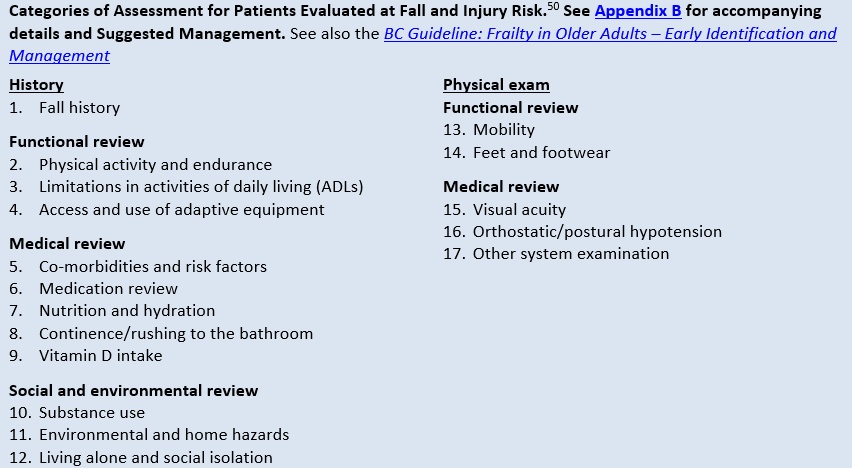The Best Guide To Dementia Fall Risk
Table of ContentsFacts About Dementia Fall Risk RevealedIndicators on Dementia Fall Risk You Should KnowThe Buzz on Dementia Fall RiskNot known Facts About Dementia Fall Risk
A loss risk evaluation checks to see exactly how most likely it is that you will certainly drop. It is primarily provided for older adults. The evaluation normally consists of: This consists of a collection of inquiries concerning your overall health and if you've had previous falls or issues with balance, standing, and/or walking. These devices check your toughness, balance, and stride (the means you walk).Interventions are recommendations that may reduce your danger of falling. STEADI consists of three steps: you for your threat of falling for your threat aspects that can be improved to try to protect against falls (for instance, balance issues, damaged vision) to minimize your threat of falling by making use of effective methods (for example, supplying education and resources), you may be asked numerous questions consisting of: Have you dropped in the past year? Are you fretted regarding falling?
After that you'll take a seat once again. Your copyright will inspect how much time it takes you to do this. If it takes you 12 secs or more, it may mean you are at higher danger for a loss. This examination checks strength and balance. You'll being in a chair with your arms went across over your upper body.
The placements will certainly obtain more difficult as you go. Stand with your feet side-by-side. Move one foot midway forward, so the instep is touching the huge toe of your other foot. Move one foot completely before the other, so the toes are touching the heel of your other foot.
The Best Guide To Dementia Fall Risk
A lot of falls occur as a result of several contributing factors; therefore, handling the risk of dropping starts with determining the factors that contribute to fall risk - Dementia Fall Risk. Some of one of the most appropriate danger factors consist of: Background of prior fallsChronic medical conditionsAcute illnessImpaired gait and equilibrium, reduced extremity weaknessCognitive impairmentChanges in visionCertain risky drugs and polypharmacyEnvironmental variables can additionally raise the danger for falls, including: Poor lightingUneven or damaged flooringWet or unsafe floorsMissing or damaged hand rails and order barsDamaged or incorrectly fitted devices, such as beds, mobility devices, or walkersImproper use assistive devicesInadequate guidance of the individuals staying in the NF, consisting of those that exhibit hostile behaviorsA effective fall risk administration program needs a thorough medical assessment, with input from all participants of the interdisciplinary group

The treatment plan should additionally consist of interventions that are system-based, such as those that promote a secure setting (suitable lighting, hand rails, get bars, etc). The performance of the interventions should be examined periodically, and the treatment plan changed as essential to show changes in the loss danger evaluation. Applying an autumn threat administration system using evidence-based ideal technique can decrease the frequency of falls in the NF, while restricting the potential for fall-related injuries.
Examine This Report on Dementia Fall Risk
The AGS/BGS guideline advises evaluating all adults aged 65 years and older for autumn threat yearly. This screening includes asking people whether they have fallen 2 or more times in the past year or sought medical interest for an autumn, or, if they have actually not dropped, whether they really feel unstable when strolling.
Individuals who have fallen once without injury ought to have their balance and gait examined; those with stride or equilibrium problems should receive added evaluation. A history of 1 fall without injury and without gait or balance issues does not call for further evaluation past ongoing yearly fall risk screening. Dementia Fall Risk. A fall risk assessment is required as component of the Welcome to Medicare exam

About Dementia Fall Risk
Documenting a falls background is one of the high quality indications for fall prevention and monitoring. A crucial component of threat assessment is a medication evaluation. Several courses of medications boost loss risk (Table 2). copyright medications in specific are independent predictors of falls. These medicines often tend to be sedating, alter the sensorium, and impair balance and gait.
Postural hypotension can typically be relieved by reducing the dose of blood pressurelowering drugs and/or quiting drugs that have orthostatic hypotension as an adverse effects. Usage of above-the-knee assistance tube and copulating the head of the bed boosted might likewise minimize postural reductions in high blood pressure. The suggested elements of a fall-focused checkup are shown in Box 1.

A yank time above or equal to 12 secs recommends high autumn threat. The 30-Second Chair Stand examination examines reduced extremity stamina and equilibrium. Being incapable to stand up from a chair of knee elevation without making use of one's arms shows raised loss threat. The 4-Stage Balance examination analyzes static equilibrium by having the patient stand in 4 settings, each considerably more challenging.